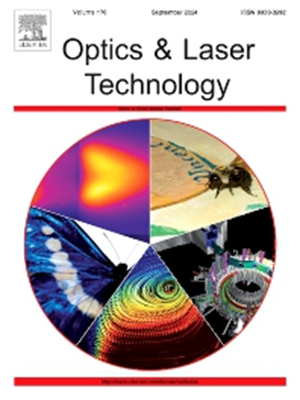Research on the forming ability and mechanism of laser impact micro isothermal forging
IF 4.6
2区 物理与天体物理
Q1 OPTICS
引用次数: 0
Abstract
High-performance monolithic forming of thin-walled complex structures from difficult-to-deform lightweight materials is an urgent need for the development of microdevices, the microforging forming of which has been an unsolved challenge. We propose a laser shock micro isothermal forging method that combines pulsed laser shock microforming and isothermal forging. The forming performance and mechanism of 2024 aluminum alloy miniature spacer frames are investigated through simulations and experiments. We examine the effects of different laser energies and forging temperatures on the forming ability of workpieces. The results show that at constant laser energy, thermal activation and dynamic recovery mechanisms cause the forming height to increase with temperature. At constant temperature, the forming height increases with increasing laser energy, but at room temperature, increasing the laser energy alone is insufficient for the desired forming. At the same laser energy, 350 °C offers better forming than 20 °C, with higher forming limits and potential for further improvement by a larger laser energy. Analysis of elastic–plastic wave transfer and stress–strain indicates that before the positive plastic wave acts on the forming, reflected elastic waves induce strain in initial contact area with the die. Material flow analysis reveals forming and reverse plastic deformation mechanisms unique to dynamic loading. Key factors include cross-region material replenishment, work hardening, and plastic wave reflection, leading to material inflow into fluted cavities and reverse plastic deformation in web regions. The degree of reverse plastic deformation increases with increasing laser energy but enhances overall formation until a threshold is reached.
求助全文
约1分钟内获得全文
求助全文
来源期刊
CiteScore
8.50
自引率
10.00%
发文量
1060
审稿时长
3.4 months
期刊介绍:
Optics & Laser Technology aims to provide a vehicle for the publication of a broad range of high quality research and review papers in those fields of scientific and engineering research appertaining to the development and application of the technology of optics and lasers. Papers describing original work in these areas are submitted to rigorous refereeing prior to acceptance for publication.
The scope of Optics & Laser Technology encompasses, but is not restricted to, the following areas:
•development in all types of lasers
•developments in optoelectronic devices and photonics
•developments in new photonics and optical concepts
•developments in conventional optics, optical instruments and components
•techniques of optical metrology, including interferometry and optical fibre sensors
•LIDAR and other non-contact optical measurement techniques, including optical methods in heat and fluid flow
•applications of lasers to materials processing, optical NDT display (including holography) and optical communication
•research and development in the field of laser safety including studies of hazards resulting from the applications of lasers (laser safety, hazards of laser fume)
•developments in optical computing and optical information processing
•developments in new optical materials
•developments in new optical characterization methods and techniques
•developments in quantum optics
•developments in light assisted micro and nanofabrication methods and techniques
•developments in nanophotonics and biophotonics
•developments in imaging processing and systems

 求助内容:
求助内容: 应助结果提醒方式:
应助结果提醒方式:


